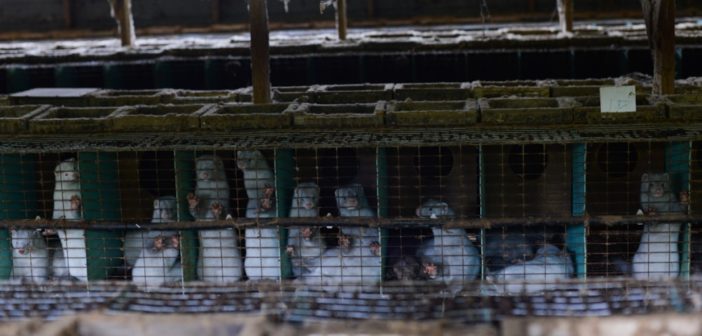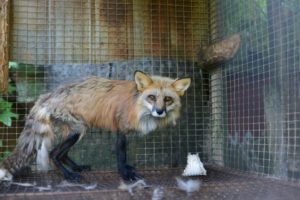85% of fur products created by the fur industry come from animals raised in captivity on fur factory farms. These farms can hold thousands of animals, and the practices used to farm them are remarkably uniform around the globe. As with other animal factory farms, the methods used on fur factory farms are designed to maximize profits, always at the expense of the animals.
Painful and short lives
The most farmed fur-bearing animal is the mink, followed by the fox. Chinchillas, lynxes, and even hamsters are also farmed for their fur. 64% of fur farms are in Northern Europe, 11% are in North America, and the rest are dispersed throughout the world, in countries such as Argentina and Russia. Mink farmers usually breed female mink once a year. There are about three or four surviving kits from each litter, and they are killed when they are about half a year old, after the first hard freeze. Mink used for breeding are kept alive for four to five years. The animals are housed in unbearably small cages and live with fear, stress, disease, parasites, and other physical and psychological hardships, all for the sake of a global industry that makes billions of dollars annually.
Rabbits are slaughtered by the millions for meat, particularly in China, Italy, and Spain. Once considered a mere byproduct of this consumption, the rabbit fur industry demands the thicker pelt of an older animal, while rabbits raised for meat are killed at the age of 10 to 12 weeks. The United Nations reports that “few skins are now retrieved from slaughterhouses,” and countries such as France are killing as many as 70 million rabbits a year for fur, which is used in clothing, as lures in flyfishing, and for trim on craft items.
Life on the “ranch”
To cut costs, fur farmers pack animals into small cages, preventing them from taking more than a few steps back and forth. This crowding and confinement is especially distressing to mink, who are solitary animals whose territory may span as many as 2,500 acres of wetland habitat in the wild. The anguish of life in a cage leads mink to self-mutilate by biting at their skin, tails, and feet, and frantically pace and circle endlessly. Zoologists at Oxford University who studied captive mink found that despite generations of being bred for fur, mink have not been domesticated and suffer greatly in captivity, especially if they are not given the opportunity to swim. Foxes, raccoons, and other animals suffer equally and have been found to cannibalize each other as a reaction to extreme confinement.
Animals on fur factory farms are fed meat byproducts considered unfit for human consumption. Water is provided by a nipple system, which often freezes in the winter or may fail because of human error.
Cages are often kept in open sheds that provide little to no protection from wind or harsh weather. Their fur alone is not enough to keep the animals warm in the winter, and in the summer, mink swelter because they have no water in which to cool themselves. When mink learn to shower themselves by pressing on their drinking water supply nipples, farmers will modify the nipples to cut off even this meager relief.
Pests and Parasites
Animals on fur factory farms are more susceptible to diseases than their free-roaming counterparts. Contagious diseases such as pneumonia are passed from cage to cage rapidly, as are fleas, ticks, lice, and mites. Disease-carrying flies thrive in the piles of rotting wastes that collect under the cages, often without being cleaned for months. Video footage and photos taken by undercover investigators at fur farms show animals suffering from severe infections and injuries, untreated and left to die slowly.
Poison and Pain
No federal humane slaughter law protects animals on fur factory farms, and killing methods are gruesome. Because fur farmers care only about preserving the quality of the fur, they use slaughter methods that keep the pelts intact, but which can result in extreme suffering for the animals. Small animals may be crammed into boxes and poisoned with hot, unfiltered engine exhaust from a truck. Engine exhaust is not always lethal, and some animals wake up while being skinned. Larger animals have clamps or a rod applied to their mouths while rods are inserted into their anuses, and they are painfully electrocuted. Other animals are poisoned with strychnine, which suffocates them by paralyzing their muscles. Gassing, decompression chambers, and neck-snapping are other common fur-farm slaughter methods.
The fur industry refuses to condemn even blatantly cruel killing methods. Genital electrocution, deemed “unacceptable” by the American Veterinary Medical Association (AVMA) 1993 Panel on Euthanasia, is a fur factory farm killing method that causes animals the pain of cardiac arrest while they are fully conscious. In 1994, Indiana became the first state to file criminal charges against a fur factory farm after PETA investigators documented genital electrocution at V-R Chinchillas. The chinchilla fur industry considers electrocution and neck-breaking “acceptable.”
In 1995, a district attorney filed charges against pelt supplier Frank Parsons of Salisbury, Maryland, for injecting a mixture of rubbing alcohol and weed-killer into the chests of mink. PETA undercover investigators videotaped Parsons using an illegal pesticide, Blackleaf 40, to painfully kill mink.
Would You Wear Your Dog?
An undercover investigation by the Humane Society of the United States, reported in a 1998 Dateline NBC piece, revealed that dog and cat fur is a multimillion-dollar industry in Asia, and found that coats and toys made with domestic dog fur were being sold in the U.S. “There are no federal laws preventing anyone from importing dog and cat fur into this country,” reported Dateline. “If the imported item costs less than $150, the importer doesn’t even have to reveal what it’s made of.” Dateline footage showed a German shepherd, tail wagging and head stuck in a restraint, moments before he was skinned alive. A cat, crowded in a cage, watched and waited his turn, as one by one, his cagemates were choked, slung up, and skinned just inches away. Since the Dateline investigation, new United States legislation outlawed the import or sale of clothing containing dog or cat fur, but the fur still enters the country illegally, since it is intentionally mislabeled and can only be detected by expensive DNA testing.
Environmental Destruction
Contrary to fur-industry propaganda, fur production is bad for the environment. The energy needed to produce a real fur coat from ranch-raised animal skins is approximately 20 times that needed for fake fur. Fur products also do not biodegrade, thanks to the chemical treatment applied to stop the fur from rotting. The process of using these chemicals is dangerous, as it can cause water contamination and harm workers.

Lack of upkeep at this mink farm has lead to years of run off and stench, which the mink must endure and which contributes to pollution and algae growth in nearby water ways. Image credit Jo-Anne McArthur / We Animals.
About 44 pounds of feces are excreted per mink skinned by fur farmers. Based on the total number of mink skinned in the U.S. annually, which is about 4 million, mink factory farms generate approximately 88,000 tons of manure per year. One result of this enormous output is over 1,000 tons of phosphorus, which wreaks havoc on water ecosystems.
Fur in Sheep’s Clothing
As fur sales decline, sales of shearling, the skin of lambs with the wool attached, have risen. Some fur manufacturers have actually taken to disguising mink as shearling. Many people are unaware of shearling’s origins, or that shearling sales are an incentive for sheep ranchers to increase their stock, thereby adding to the plight of sheep.
In Afghanistan, karakul sheep are now raised to produce lambs for the high-end market in “Persian lamb” coats and hats. For “top-quality” lamb skin, the mother is killed just before giving birth and her fetus is cut out. The pelts of the unborn lambs are prized in the fashion world for their silk-like sheen. It takes the skin from an entire lamb to make one karakul hat.
Humane Choices
Consumers need to know that every fur coat, lining, or item of trim represents the intense suffering of several dozen animals, whether they were trapped, ranched, or even unborn. These cruelties will end only when the public refuses to buy or wear fur. Those who learn the facts about fur must help educate others, for the animals’ sake.
Featured image: Mink on a fur farm. Image credit Jo-Anne McArthur / We Animals.







